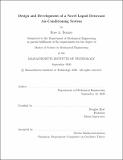| dc.contributor.advisor | Douglas Hart. | en_US |
| dc.contributor.author | Bonner, Ross A.(Ross Anthony) | en_US |
| dc.contributor.other | Massachusetts Institute of Technology. Department of Mechanical Engineering. | en_US |
| dc.date.accessioned | 2021-01-05T23:13:43Z | |
| dc.date.available | 2021-01-05T23:13:43Z | |
| dc.date.copyright | 2020 | en_US |
| dc.date.issued | 2020 | en_US |
| dc.identifier.uri | https://hdl.handle.net/1721.1/129027 | |
| dc.description | Thesis: S.M., Massachusetts Institute of Technology, Department of Mechanical Engineering, 2020 | en_US |
| dc.description | Cataloged from student-submitted PDF of thesis. | en_US |
| dc.description | Includes bibliographical references (pages 105-108). | en_US |
| dc.description.abstract | The Direct Evaporative Closed Air Loop (DECAL) system is a novel high efficiency liquid desiccant air-conditioning (LDAC) system which runs primarily on thermal energy rather than electricity. It is designed for residential cooling in hot and humid climates where demand is growing rapidly and incumbent direct-expansion system performance is poor. Unlike other LDAC systems, DECAL is modular. This allows the indoor hardware to remain small and non-intrusive, and offers increased flexibility to install the system in existing building stock without costly changes to the structure. This work lays out the basic operating cycle of the DECAL system and shows its thermodynamic merits in terms of ideal system performance against other LDAC systems. Design studies show DECAL offers improved thermal efficiency, especially in humid climates. The ideal thermal coefficient of performance (COP[subscript th]) is 1.24 at the design point ambient condition of 35C, 60% RH. | en_US |
| dc.description.abstract | A mathematical model is built to better characterize performance and optimize the system design. With transport inefficiencies included, the optimal system electrical and thermal COP (COP[subscript e] and COP[subscript th]) are 46.3 and 0.759 respectively for a LiCl system at the design point. These results show the DECAL system could reduce electrical consumption by over 85% from present day best-in-class systems using low-grade thermal energy. A benchtop scaled test of the closed air loop is constructed to validate the model. Experimental test results agree well with the model predictions for evaporative cooling effectiveness and sensible heat exchange, as well as pressure drop. The drying effect of the LAMEE is lower than anticipated. This is likely due to crystallization of liquid desiccant in the pores of the membrane, resulting in a high vapor diffusion resistance. Adjusting for this effect, full system test measurements match the system model well. | en_US |
| dc.description.abstract | The benchtop rig testing verified that the closed air loop is capable of generating a sensible cooling effect, but further testing is required to demonstrate modelled figures of merit are achievable. | en_US |
| dc.description.statementofresponsibility | by Ross A. Bonner. | en_US |
| dc.format.extent | 108 pages | en_US |
| dc.language.iso | eng | en_US |
| dc.publisher | Massachusetts Institute of Technology | en_US |
| dc.rights | MIT theses may be protected by copyright. Please reuse MIT thesis content according to the MIT Libraries Permissions Policy, which is available through the URL provided. | en_US |
| dc.rights.uri | http://dspace.mit.edu/handle/1721.1/7582 | en_US |
| dc.subject | Mechanical Engineering. | en_US |
| dc.title | Design and development of a novel liquid desiccant air-conditioning system | en_US |
| dc.type | Thesis | en_US |
| dc.description.degree | S.M. | en_US |
| dc.contributor.department | Massachusetts Institute of Technology. Department of Mechanical Engineering | en_US |
| dc.identifier.oclc | 1227042713 | en_US |
| dc.description.collection | S.M. Massachusetts Institute of Technology, Department of Mechanical Engineering | en_US |
| dspace.imported | 2021-01-05T23:13:41Z | en_US |
| mit.thesis.degree | Master | en_US |
| mit.thesis.department | MechE | en_US |
